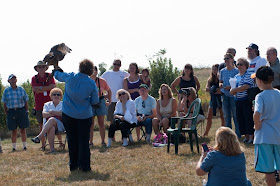
The kite stills spends most of its time, including early mornings and late afternoons or evenings, at Stratford Point. If there are only a few people on the site it will often stick around for the full day. It will sometimes go to the cedar trees far down on U.S. Fish and Wildlife property at Milford Point. Now and then, it can be found in the trees behind the tennis courts at Short Beach, or even on a snag in the scrub directly adjacent to the beach.


While the next week will bring some cooler weather to Connecticut, there still seems to be no departure date for the kite. Perhaps, if we can finally get a strong cold air mass to move in, it will decide to move out. We will keep you updated. The next couple of photos are a bit gruesome, with the kite carrying partially eaten prey - do not take a look at them if that sort of thing bothers you.


In the mean time, you should come see it, especially if you have yet to take the trip. A great time would be during the Yale Peabody Museum's Stratford BioBlitz, October 8-9. The gate will be open for all visitors on Saturday the 9th. You will be able to enjoy guided walks and, of course, the opportunity to see the kite at a convenient time. Let us hope it stays through then.
Photos © Kevin M. Doyle






































